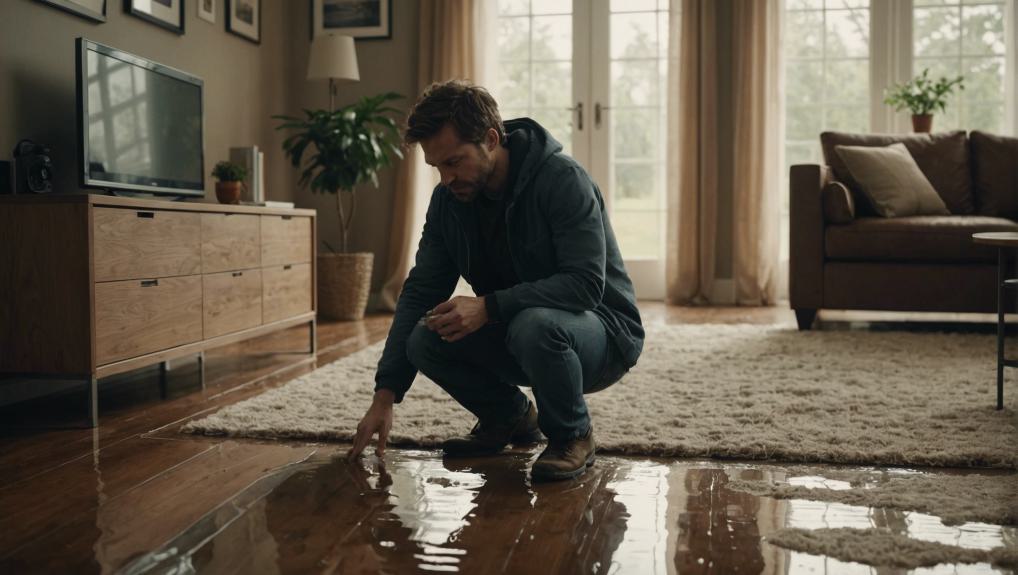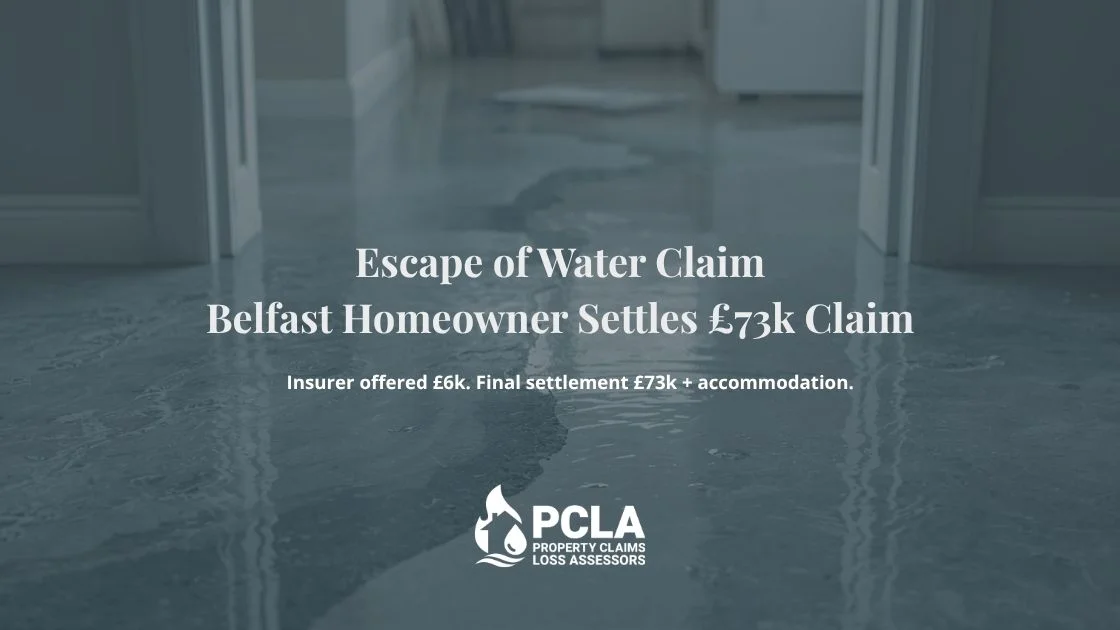Home insurance can sometimes be a maze of clauses and fine print, especially when it comes to water damage from underfloor leaks. In this article, we break down the essentials of what is typically covered under home insurance and how you can protect yourself from unexpected repair costs.
Does Home Insurance Cover Underfloor Leaks?
Yes, home insurance can cover underfloor leaks, but it depends on the specific circumstances and your policy’s fine print. Typically, your buildings insurance will handle the damage that results from such leaks. However, remember, gradual damage due to slow leaks or wear and tear is often excluded, this is especially the case if it would have been expected for this damage to be noticed sooner. Also you’ll want to check the ‘trace and access’ provisions in your policy – this helps to recover the cost of leak detection.
Key Takeaways
- Home insurance generally covers water damage from underfloor leaks.
- Coverage usually excludes leaks caused by wear and tear or lack of maintenance.
- Buildings insurance policies typically cover structural elements, including floors affected by underfloor leaks.
- Trace and access costs to locate the leak are often covered by many home insurance policies.
- Repair or replacement costs of the leaking pipe or appliance itself are usually not covered.
Understanding Underfloor Leaks

Picture the first signs of an underfloor leak: wooden floors beginning to cup, or plaster at the base of a wall showing damp damage. Underfloor leaks, often originating from burst pipes or malfunctioning appliances, can lead to significant structural damage if not addressed promptly.
These types of leaks, referred to in the insurance industry as “escapes of water,” are frequent yet challenging to identify. Early detection is essential, and utilising professional services can prevent extensive and costly repairs.
It is not uncommon for a small, undetected, underfloor leak to escalate, leading to extensive damage at a property, requiring a substantial drying programme and major works to repair.
While buildings insurance often covers the resultant damage, it typically does not cover the cost of repairing the burst pipe or malfunctioning appliance. Understanding this distinction is critical for effectively navigating your insurance coverage.
Reviewing your buildings insurance policy can provide clarity on what’s covered. For instance, while water damage from an escape of water is generally covered, wear and tear or poor maintenance may not be.
Are leaks covered by a standard home insurance policy?
Before we get into underfloor leaks, it’s important to define what an insurance company means by a ‘leak’.
It’s not a leak, it’s an escape of water!
According to MORE THAN:
“Escape of water is the technical term used to describe a leak in your home. It could include situations such as a burst pipe or a faulty washing machine connection. If water has escaped from where it is meant to be and caused sudden damage to your home, then we’re talking about an ‘escape of water’ claim on your home insurance policy.”
MORE THAN
What leaks are covered under standard home insurance?
You can never be certain about what’s covered, which is why we recommend giving us a call if you have discovered a leak. We’ll help you understand if and how you can make a claim for everything you are entitled to. Making sure you discover the full extent of the damage can be the difference between a successful claim and an unsuccessful one.
Depending on what has been water damaged, you may be claiming under the buildings section of your policy, the contents section, or both.
In general, if the leak results from a failure in any of the following, you should be able to make a claim:
- Burst pipes
- Blocked toilets
- Water tanks
- Radiators
- Central heating boilers
- Washing machines
- Dishwashers
- Shower
- and your bath
When is a leak not covered?
Escape of water coverage may not extend to the following items – you will need to check your policy wording to be sure:
- Wear and Tear: Damage caused by lack of maintenance to your grout or sealant or if your pipes degrade over time, may not be covered.
- Lack of Maintenance: If leaks result from neglected maintenance, insurers might deny your claim.
- Improper Installation: Faulty installation of pipes or appliances that leads to leaks can be a reason for denial.
- Gradual Damage: Slow, unnoticed leaks causing damage over time may not be covered. Sudden incidents are usually necessary for a claim.
- Secondary Damage: Costs to repair or replace the leaking item itself, like a burst pipe, are often excluded, even if the policy covers damage caused by the leak.
- Dripping taps, while annoying will not usually be covered
- A burst pipe outside which has not caused damage to your contents or the interior of your property
These exclusions highlight the importance of regular maintenance and prompt attention to potential issues in your home. Always review your policy details and consult with your insurer to fully understand what your home insurance covers.
Whilst an untrained person may dismiss the damage and decide that you can’t claim, it’s best to get reassurance from a professional loss assessor. As qualified building surveyors and insurance claim experts, PCLA know how to identify water damage and negotiate a successful claim on your behalf. Don’t miss out on your claim, contact us today to find out how we can help you.
What is trace and access cover?
Trace and access cover is a provision within a policy that covers the cost of finding and accessing a water leak in your home. If you have a water leak, burst pipe, or other problem with your plumbing that is difficult to locate, trace and access cover can help pay for the cost of finding the source of the leak, although this typically does not extend to the cost of fixing it.
A standard buildings policy will then typically take over and cover the costs of fixing the damage that the leak has caused. This can be damage to walls, floors, or furniture, etc.
Today, Trace and Access is typically included as standard in most policies, often with a limit of up to £5,000 for locating the source of a leak. However, it’s important to check with your home insurer, as some policies may still not offer this coverage as standard.
Am I covered for trace and access as standard?
Trace and access cover is usually included in most insurance policies, you can usually see from your policy schedule or booklet if this is included.
What are trace and access costs?
Most buildings insurance policies include trace and access cover as standard, usually up to £5000, which can pay for the cost of a plumber or specialist leak detector to identify that there is a leak, locate it, and reinstate any areas that have been opened up to get access to it.
This could mean lifting floorboards, opening up a screed floor or knocking holes in walls. Anything that is damaged in the process of exposing the pipework and tracing the leak is considered a cost that should be recoverable under the trace and access section.
Don’t forget, any damage to your contents can be claimed for under your contents insurance.
How do I make a trace and access insurance claim?
To make a claim under the Trace and Access section of your insurance policy, follow these steps, or let PCLA handle everything for you:
- Identify the Leak: If you suspect a leak in your home but can’t find the exact source, you’ll need to hire a professional, such as a plumber or leak detection specialist, to locate and expose the problem. PCLA can arrange this for you, ensuring that everything is handled professionally and efficiently.
- Contact Your Insurer: Once the leak is identified, you must notify your insurer to make a claim under the Trace and Access section, which covers the costs of locating and accessing the leak. If there is resulting water damage from the leak, then a further claim for buildings damage will be required. PCLA can manage this entire process, contacting your insurer on your behalf to ensure all necessary steps are taken.
- Submit Supporting Evidence: Your insurer will require documentation, such as reports or invoices from the professional who detected the leak. PCLA will collect and submit all the required evidence, making the claims process smoother and stress-free for you.
- Claim Assessment: The insurer will assess whether your claim falls within your policy’s Trace and Access cover, typically covering the costs of leak detection. Subsequent water damage will then be dealt with under the ‘Escape of water’ section of the policy. PCLA will work with your insurer to ensure they properly assess and approve your claim, negotiating on your behalf to secure the best outcome.
- Settlement and Repairs: Once your claim is approved, the insurer will reimburse the costs of locating the leak and restoring the damaged areas. With PCLA managing the entire process, we ensure that you’re fully reimbursed for all repair costs, and we can oversee the reinstatement work as well.
By choosing PCLA, you can have peace of mind knowing that we’ll handle every step of your claim, ensuring you receive the full coverage and support you’re entitled to without the hassle of dealing with insurers yourself.
How can you tell if you have an underfloor leak?
There are a few ways you can tell if you have an underfloor leak. You may notice water stains or damp patches on your walls, or hear the sound of running water even when all your taps are turned off. If you have a water meter, you might also notice a sudden increase in your water usage.
Wooden floors may begin to ‘cup’ or warp. Floor tiles may become cracked or boast and increased condensation may be noticeable within the property, particularly on windows in the morning.
If the leak is in your heating system, you may notice that your water pressure is dropping and needs to be topped up regularly or that the heating isn’t working properly.
These are all strong indications that you have a hidden water leak. However, the most common leaks are easily discovered – you’ll discover a puddle on your floor or drips from the ceiling!
What to do if you discover a leak
If you think you have an underfloor leak, the first thing you should do is turn off the stopcock to cut off the water supply and limit any potential damage. Underfloor leaks can be tricky to detect and may cause significant hidden damage if not dealt with promptly.
For minor leaks, you might be able to manage small repairs yourself, such as tightening a visible pipe or joint. However, an underfloor leak is more complicated and could result in extensive damage to your flooring and home structure, potentially leading to costly repairs. By their very nature, these are typically something that requires a qualified plumber of leak detection specialist to find and repair.
In this case, we strongly recommend getting in touch with PCLA to speak with one of our independent loss assessors. We offer free, impartial advice and can guide you through handling an underfloor leak, including assistance with getting the leak found and making a claim on your home insurance policy. Let us take the hassle out of the situation by ensuring you get the support you need to protect your home and finances.
Making an insurance claim for an underfloor leak
If you discover damage caused by a leaking underfloor pipe and want to make a claim, there are some things you should consider first.
Your insurance company may decide to send a loss adjuster to investigate the cause of the leak and the extent of the damage. Once the loss adjuster has finished their investigation, they will prepare a report for your home insurance provider. This report will be used to determine whether or not your claim is covered by your home insurance policy.
It’s up to you to be able to negotiate with the loss adjuster and your insurance company. However, you can appoint an independent loss assessor to work on your behalf. It’s their job to submit a full claim for all of the water damage to your property.
Call PCLA today
We all know that water damage is a pain, but it’s especially difficult when it’s caused by a leak in an underfloor pipe.
Not only is it hard to spot, but it can go undetected for a long time. And left untreated it has the potential to cause a lot of damage to your home.
With PCLA, you can rest assured that you’ll get the help and support you need.
We can help you make a claim on your home insurance for water damage caused by a leaking underfloor pipe. We have a team of experienced professionals who can help you get the compensation you deserve. Contact us today to learn more about how we can help you!



